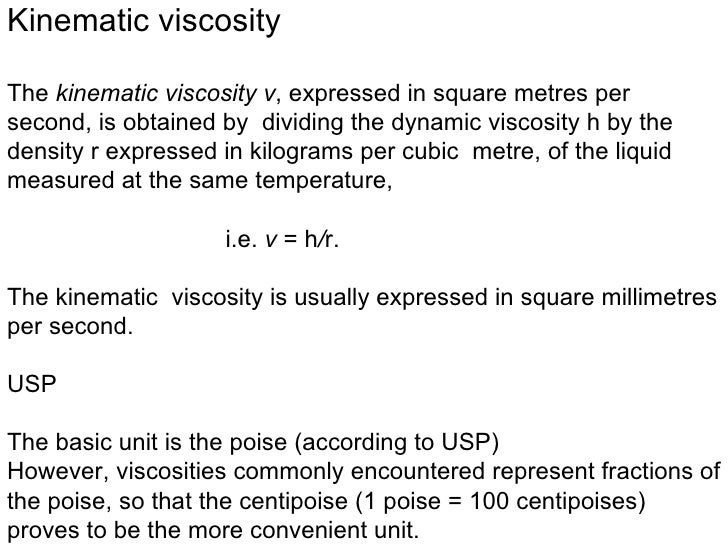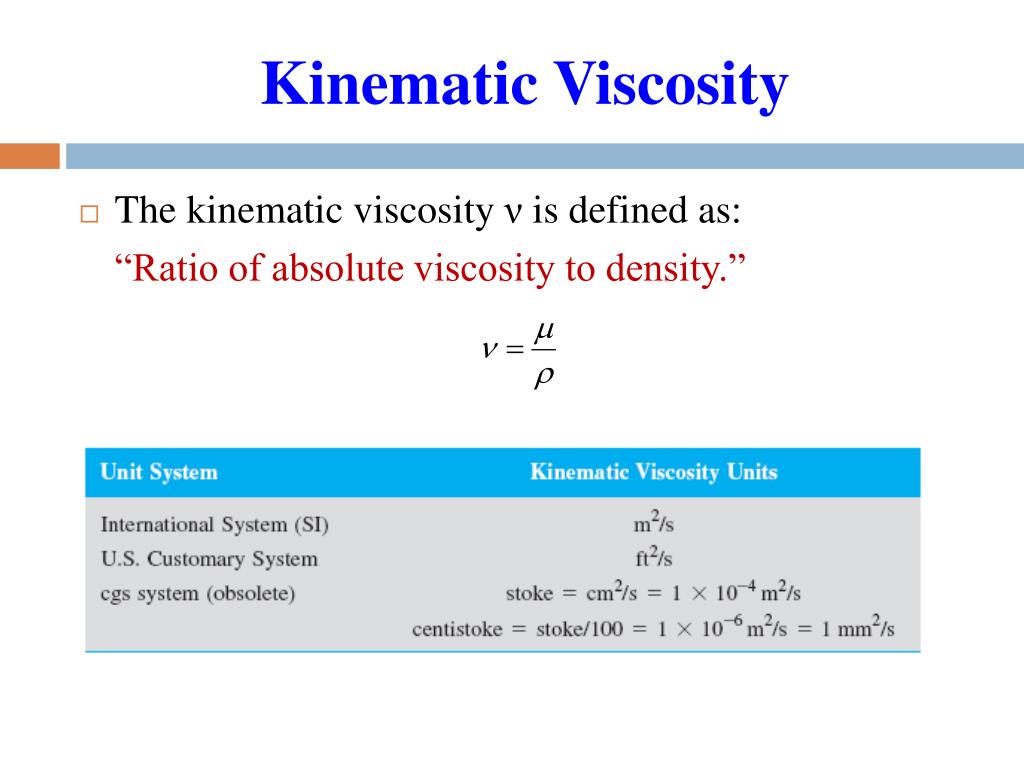
Therefore, the density of fluid is 0.445 kg per cubic m. Formula for Kinematic ViscosityĪs we know that it is the ratio of dynamic viscosity to fluid mass density. Kinematic viscosity can be computed by dividing the absolute viscosity of a fluid with the fluid mass density. This is the ratio of the dynamic viscosity to its density, i.e. Therefore, Kinematic viscosity is the measurement of the inherent resistance of a fluid to flow when no external force is imparted except gravity. The units of kinematic viscosity are established on time and area of fluid. It is from time to time also known as momentum diffusivity. Whereas Kinematic viscosity is the sort of viscosity that is computed by calculating the ratio of the fluid mass density to the dynamic fluid, viscosity or absolute fluid viscosity. The shearing stress between the layers of a no turbulent fluid which is moving in straight parallel lines may be defined for a Newtonian fluid.

It is at a unit velocity while maintaining a unit distance apart in the fluid. dynamic viscosity coefficient is a measure of internal resistance. There are two related measures of fluid viscosity: Dynamic and Kinematic.Ībsolute viscosity i.e. Viscosity is a concept where fluid shows struggle against a flowing, which is being distorted due to extensional stress forces or shear stress. It appears Stokes and Poise got the same answer just in two different ways.3 Solved Examples for Kinematic Viscosity Formula Definition of Kinematic Viscosity If you divide kinematic viscosity by the fluid density, you get absolute viscosity. Thus, dynamic viscosity is a measure of force, while kinematic viscosity is a measure of velocity. Kinematic viscosity incorporates fluid density as part of its measurement. This means the fluid’s weight or density helps it to flow. There is no external force pushing the fluid. It is the time it takes to have a known amount of fluid flow a given distance. The formula for kinematic viscosity is 1 centistoke (cSt) equals 1 millimeter squared per second (mm 2/s). This viscosity measurement was given the term kinematic. Again, centistokes (cSt) is used for easier readings. These tests led to Stokes’ law and a different form of viscosity measurement.

He tested this theory by putting fluid in a glass tube and measuring how long it took for the fluid to flow a certain distance. Stokes surmised there was some type of internal friction in the fluid causing the different rates of falling. He discovered that the same particle sank at different rates in different fluids. Therefore, this type of viscosity measurement requires an external force in order to be measured.Ībout the same time Poise was performing his tests, an Irishman named Sir George Stokes was dropping particles into fluids and measuring how fast they fell to the bottom. Pascal is a unit of force just like horsepower.

The formula for dynamic or absolute viscosity is 1 centipoise (cP) equals 1 millipascal-second (mPa-s). The term dynamic or absolute is used for this viscosity measurement. To make readings easier, centipoise (cP) is preferred for lubricant viscosities. This internal friction is measured by the force needed to make it flow and was given the measurement name of poise.

Low viscosity fluid flows easily because its molecular structure results in less friction when it is in motion. A fluid with a high viscosity is resistant to motion because its molecular composition provides a lot of internal friction. It explains the internal friction of a flowing fluid. This led him to conclude that different fluids have an internal friction which must be overcome by an external force in order to flow. Viscosity is a measure of the fluids resistance to flow. Poiseuille found that different blood flowed at different speeds through the glass tubes with the same amount of force. This article explains the differences.Īround 1840, a French mathematician named Jean Leonard Marie Poiseuille conducted tests involving the flow of blood through small glass tubes. This resistance is measured by two different methods. The definition of lubricant viscosity is the fluid’s resistance to flow and shear. Viscosity is the utmost characteristic of a lubricant.


 0 kommentar(er)
0 kommentar(er)
